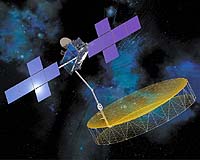 |
Dulles VA (SPX) Jul 09, 2009 Orbital Sciences has announced that it has been selected by the National Aeronautics and Space Administration (NASA) to design, manufacture, integrate and test a new low-Earth orbit (LEO) space science satellite that will study X-ray polarization in space. Under the $40 million contract, Orbital will provide the spacecraft bus and conduct mission operations for the Goddard Space Flight Center's (GSFC) Gravity and Extreme Magnetism (GEMS) mission. The GEMS contract was awarded to Orbital under the space agency's Small Explorer (SMEX) series of cost efficient and highly productive space science satellites. Orbital has built several other SMEX satellites for NASA, including the in-orbit GALEX, AIM and IBEX spacecraft, and is currently developing the NuSTAR spacecraft that is scheduled for launch in 2011. The GEMS mission is being led by the project's Principal Investigator Dr. Jean Swank and is being managed by GSFC. It is currently scheduled to launch no later than 2015. "Orbital is very pleased to be able to continue our support for NASA's SMEX program with our selection by the Goddard Space Flight Center to build and operate the GEMS satellite," said Mr. Mike Miller, Orbital's Senior Vice President for Science and Technology satellite programs. "With our proven capabilities to build and deploy very reliable satellites to support the nation's space science research, we are looking forward to working with Dr. Swank and her team on another important mission." The GEMS satellite will be the first observatory to systematically measure X-ray polarization which encodes information about the structure of cosmic sources, unlocking a previously hidden astrophysical world. Previous space-based X-ray observatories have been insensitive to polarization, which refers to the direction of the electric field of electromagnetic waves. Polarization measurements will allow scientists to study scattering, magnetic fields and strong gravitational fields. "The collaboration among the GEMS participants during the study phase resulted in a strong team that was selected by NASA from among several other proposed missions to go forward with its important scientific research," said Dr. Swank. "Over the next several years, we look forward to completing the satellite and flying a mission that will add important and useful new information to the study of astrophysics." The purpose of the GEMS mission is to help scientists answer fundamental questions about the universe, such as: Where is energy released near black holes? What is the origin of X-ray emissions from pulsars? What is the magnetic field structure in high energy nebulae? The GEMS team will make the data from the mission readily accessible to the astrophysics community and the general public on NASA's High Energy Astrophysics Science Archive Research Center website. The GEMS satellite will be based on Orbital's proven LEOStar-2 TM spacecraft bus design. GEMS will be the eighth satellite to be based on the LEOStar-2 platform. Other LEOStar-based satellites that Orbital has built or currently has in development for NASA include the four SMEX satellites mentioned above, plus the Dawn interplanetary spacecraft that was launched in 2007 and the SORCE Earth science satellite that is currently in its seventh year of operation. In addition to its program management role, NASA's GSFC will provide the X-ray polarimeter instrument and oversee the Science Operations Center, science data processing, systems engineering and education and public outreach. Other program partners include NASA's Ames Research Center, the University of Iowa and ATK, Inc. Share This Article With Planet Earth
Related Links NASA High Energy Astrophysics Science Archive Research Center Space Technology News - Applications and Research
 Satellite Successfully Performs Post-Launch Maneuvers
Satellite Successfully Performs Post-Launch ManeuversPalo Alto CA (SPX) Jul 03, 2009 Space Systems/Loral (SS/L) has announced that the satellite it built for TerreStar Networks is successfully performing post-launch maneuvers. The world's largest commercial satellite deployed its solar arrays Wednesday evening, following its launch aboard an Ariane 5 rocket from the European Spaceport in Kourou, French Guiana. The satellite's first thruster firing will begin later today, ... read more |
|
| The content herein, unless otherwise known to be public domain, are Copyright 1995-2009 - SpaceDaily. AFP and UPI Wire Stories are copyright Agence France-Presse and United Press International. ESA Portal Reports are copyright European Space Agency. All NASA sourced material is public domain. Additional copyrights may apply in whole or part to other bona fide parties. Advertising does not imply endorsement,agreement or approval of any opinions, statements or information provided by SpaceDaily on any Web page published or hosted by SpaceDaily. Privacy Statement |